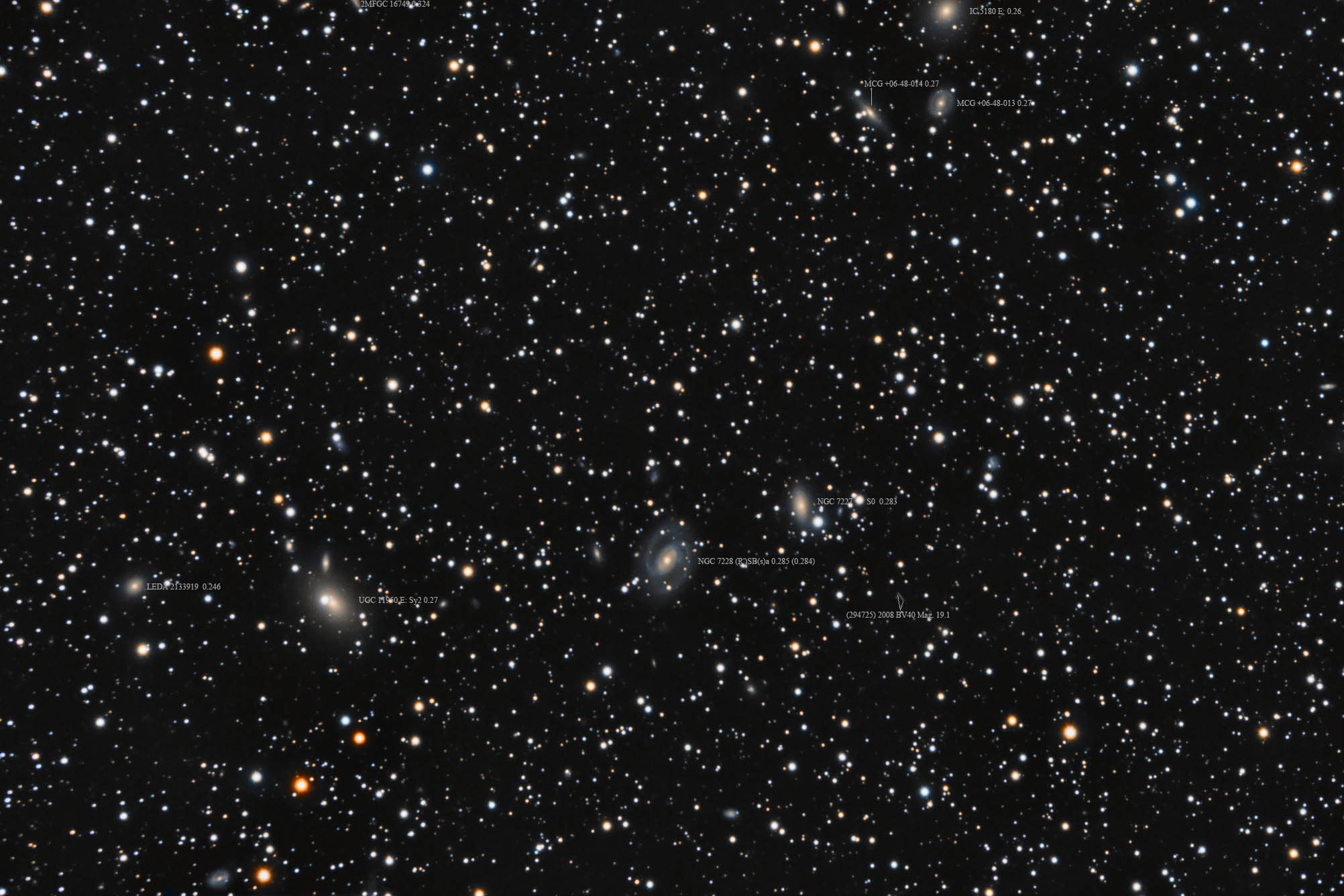Object name: NGC7227Designation(s): NGC7227, NGC7228, IC5180, MCG+06, 45, 013, UGC11960, This field of galaxies a bit over a quarter of a billion light-years distant is rarely imaged by amateurs. I found only one color amateur image and only a couple more mono images. The main three galaxies form a triplet known at NED as UZC-CG 276. That stands for the Updated Zwicki Catalog-Compact Groups. It was searching this catalog that led me to this field. Near the center is NGC 7228 whose outer arms form a ring coming from the bar of an SBa type galaxy. Usually, a SBa galaxy has rather tight arms, not the wide spaced ones seen here. Makes me wonder if the outer faint arms were even seen when it was categorized. The redshift and Tully-Fisher distances are almost exactly the same, varying only at the 3rd decimal point. I can't recall seeing any that agreed this well. Thanks to its widely spaced but extremely faint outer arms I measure its size at 150,000 light-years making it a very large spiral.
The other NGC galaxy in the field is NGC 7227 to the west, it is listed as an S0. It seems to show some hints of spiral structure and has a redshift almost identical to that of NGC 7228. The third member of the group is UGC 11960 an Elliptical galaxy with a Seyfert 2 nucleus. Its redshift puts it very slightly closer but I suspect that's mostly due to relative velocity in the group and it really is at virtually the same distance as the other two. Besides being a Seyfert 2 galaxy it shows in radio to be a very extended S-shaped radio source. Both its Seyfert status and radio signature likely are the result of something it is still digesting.
LEDA 2133919 is too distant (angular distance) to make the cut for a compact group but may also be a true member with its redshift again due to high speed motion in our direction. More likely it is not a member. The group and its surroundings are too poorly studied to determine which is the case. Three other galaxies that are likely group members are at the top of my frame. They are at 260 to 270 million light-years distant.
The only other galaxy with redshift data is a flat galaxy, 2MFGC 16749 mostly off the top of my image. Only its southern end made it into my image. It has a greater redshift than the others indicating it likely is unrelated to the others at a distance of 324 million light-years about 40 million light-years beyond the two NGC galaxies. But it could just have a high relative velocity. I consider this unlikely, however.
This field is so poorly studied only these 8 galaxies have any redshift data that I could find. Many more interesting galaxies are in the field that too may be part of the group but with nothing more to go on it can't be determined which, if any are group members.
The two NGC galaxies were discovered by Édouard Stephan on September 1, 1879. How he missed the third member I don't know as he was using a 31" reflector. IC 5180 was found by Guillaume Bigourdan on September 21, 1890.
There's one asteroid in the image southwest of NGC 7227, (294725) 2008 BV40 with an estimated 19.1 magnitude by the Minor Planet Center. I get a magnitude of 19.3.
14" LX200R @ f/10, L=4x10' RGB=2x10', STL-11000XM, Paramount ME Related Designation(s):2MASS J22111200+3855379, 2MASS J22113130+3843168, 2MASS J22114859+3841570, 2MASS J22143783+4126237, 2MASX J22111201+3855384, 2MASX J22113134+3843168, 2MASX J22114860+3841569, 2MASX J22143784+4126235, 2MASXi J2211120+385537, 2MASXi J2211313+384316, 2MASXi J2211486+384156, 2MASXi J2214378+412623, CGCG 2209.0+3840, CGCG 2209.3+3828, CGCG 2209.6+3827, CGCG 513-011, CGCG 513-012, CGCG 513-013, CRATES J2211+3855 NED03, CRATES J221112.01+385537.9, GALEXASC J221112.03+385537.7 , GALEXASC J221148.38+384159.5 , HDCE 1178 NED003, HDCE 1178 NED004, HDCE 1180 NED001, IC 5180, IC5180, ISOSS J22146+4127, LDCE 1520 NED003, LDCE 1520 NED004, LDCE 1520 NED006, MCG +06-48-012, MCG +06-48-015, MCG +06-48-016, MCG+06 45 013, NGC 7227, NGC 7228, NGC7227, NGC7228, PGC 068234, PGC 068243, PGC 068254, PGC 068372, UGC 11938, UGC 11942, UGC 11945, UGC 11960, UGC11960, USGC U809 NED05, USGC U809 NED06, USGC U809 NED07, UZC J221112.0+385537, UZC J221131.3+384316, UZC J221148.6+384156, UZC-CG 276 NED01, UZC-CG 276 NED02, [SLK2004] 1764, | | 
